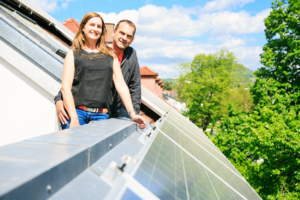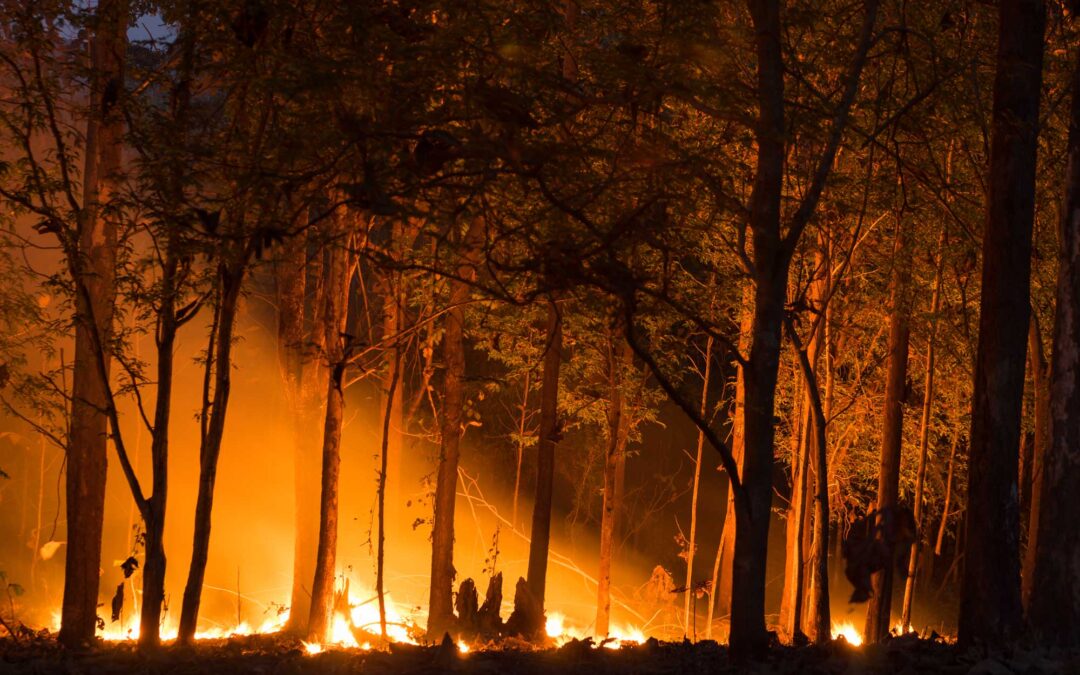It would be incredibly difficult to not know that across the United States multitudes of wildfires have broken out in the last few weeks. And with a record-breaking heatwave combined with a lingering drought, many homeowners are realizing they are overdue for some home hardening to protect their property.
The high heat combined with severely dry conditions has meant that anything flammable has become exceptionally prone to ignition. And this also means that anything potentially flammable near a structure can be sufficient fuel to destroy it.
This is not the time to leave home hardening for just those living in or near wooded areas.
High Winds and High Heat Equal High Danger from Flying Embers
Image courtesy Wikipedia
In 2017 the Tubbs Fire devastated Sonoma and Napa Counties in California. Although the fire began in a rural area of Napa County, some of the worst devastation occurred in the heart of the the urban areas of Santa Rosa, particularly in the Coffee Park neighborhood where close to an estimated 1,300 structures, mostly detached homes, were leveled.
 Meanwhile, alongside Highway 101, the Fountaingrove Inn, the historic Fountaingrove Round Barn, and a large Hilton hotel were destroyed, as were 116 of the 160 units at the neighboring Journey’s End Mobile Home Park. All of these were burned to the ground. Additionally, along several streets also bordering Highway 101, a Kmart store and numerous restaurants also burned to the ground.
Meanwhile, alongside Highway 101, the Fountaingrove Inn, the historic Fountaingrove Round Barn, and a large Hilton hotel were destroyed, as were 116 of the 160 units at the neighboring Journey’s End Mobile Home Park. All of these were burned to the ground. Additionally, along several streets also bordering Highway 101, a Kmart store and numerous restaurants also burned to the ground.
Being near an urbanized “city center” did not protect these structures from the ravages of a “wildfire.”
When the Water is Scarce, and the Temperatures are Rising
Up until about 2017, far too many homeowners gave little thought to the very real dangers of wildfires. Regardless of what one may believe to be the underlying or contributing causes, the fact is that much of the western United States has experienced an unprecedented number of destructive and devastating fires.
Consider the state of California, for example.
According to an article from The Sacramento Bee published in late 2020,
“Five of the 13 most destructive wildfires in state history sparked within the past five years in the Napa-Sonoma area: this year’s Glass and LNU Complex fires, the Tubbs Fire and Nuns Fire in October 2017 and the September 2015 Valley Fire. Those major blazes have combined for 34 confirmed deaths — 22 in the Tubbs Fire, five in the LNU Complex, four in the Valley Fire and three in the Nuns Fire.”
Of course, California isn’t alone in living with the risk of wildfires and losing homes and lives.
According to fire loss data from the Insurance Information Institute,
“In 2020 there were 58,950 wildfires compared with 50,477 in 2019, according to the National Interagency Fire Center. About 10.1 million acres were burned in 2020, compared with 4.7 million acres in 2019.”
And, as of late July 2021, over 36,460 fires had already destroyed more than 2,770,450 acres.
Home Hardening and Staying Green
Home hardening may not be a familiar concept to everyone; however, it has become so for those living in or near wildfire ravaged communities.
One article explained home hardening this way,
“Hardening your home against wildfire just means taking steps to improve the chance of your home and structures withstanding ignition by the inevitable wildfire, firebrands and other factors we face every year. Hardening your home starts with easy, small steps that can make all the difference.”
There are three ways your home can be exposed to wildfire: direct flames from a wildfire or burning neighboring home; radiant heat from nearby burning plants or structures; and flying embers.
Flying embers from a wildfire can destroy homes up to a mile away and are responsible for the destruction of most homes during a wildfire. Consequently, it pays to engage in at least a minimal level of home hardening, even if your home is situated miles from any areas prone to wildfires.
The following tips and best practices for home hardening were adapted from information provided by Cal Fire’s ReadyForWildfire.org website:
- Roof
The roof is the most vulnerable part of your home. Homes with wood or shingle roofs are at high risk of being destroyed during a wildfire.
- Vents
Vents on homes create openings for flying embers. Cover all vent openings with 1/16-inch to 1/8-inch metal mesh.
- Eaves and Soffits
Eaves should be boxed in (soffited-eave design) and protected with ignition-resistant or non-combustible materials.
- Windows
Heat from a wildfire can cause windows to break even before the home is on fire, allowing burning embers to start fires inside. Single-paned and large windows are particularly vulnerable.
- Walls
Wood products, such as boards, panels or shingles, are common siding materials. However, they are flammable and not good choices for fire-prone areas.
- Decks
Surfaces within 10 feet of the building should be built with ignition-resistant*, non-combustible, or other approved materials.
- Rain Gutters
Keep rain gutters clear or enclose rain gutters to prevent accumulation of plant debris.
- Patio Cover
Use the same ignition-resistant materials for patio coverings as a roof.
- Chimney
Cover your chimney and stove pipe outlets with a metal screen with openings no smaller than 3/8-inch and no larger than 1/2-inch to prevent embers from escaping and igniting a fire.
- Garage
Have a fire extinguisher and tools such as a shovel, rake, bucket, and hose available for fire emergencies. Add a battery back-up to the garage door motor in case the power goes out.
- Fences
Best practice is to separate your fence from your house or upgrade the last 5-feet of the fence to a noncombustible material to reduce the chance of the fence from bringing fire to your home.
- Driveways and Access Roads
Driveways should be built and maintained per state and local codes to allow access to fire and emergency vehicles. Maintain access roads with at least 10 feet of clearance on either side for two-way traffic.
- Address
Make sure your address is clearly visible from the road.
- Water Supply
Consider having multiple garden hoses that are long enough to reach all areas of your home and other structures on your property. If you have a pool or well, consider getting a pump.
Rely on a Green Building Consultant for a Sustainable – and Safe – Home
Green living is not only attainable, but sustainable. As experienced and knowledgeable professionals, we can make the process much easier for homeowners, contractors, and business owners who want to benefit by implementing green and sustainable building practices.
Whether you’re a contractor about to build a home, a homeowner planning to build your own home or an addition, or a business owner who wants to create a more sustainable facility, investing in sustainability consulting will benefit you.
A sustainable construction consultant, can provide guidance and direction for any aspect of a project, whether it involves new construction, retrofitting for energy efficiency, adding or upgrading energy saving components, or home hardening best practices.
An experienced construction consultant, can guide you in all the phases of your project and answer any questions. To learn more, email us at crystalconstruction@aol.com or give us a call at (707) 865-5157.

